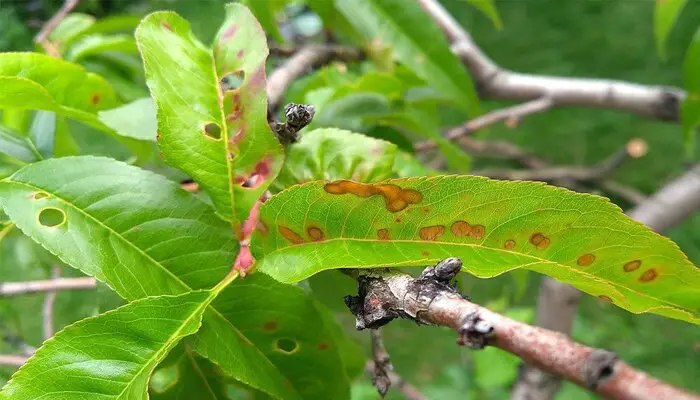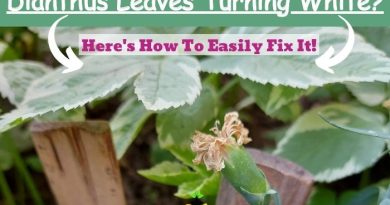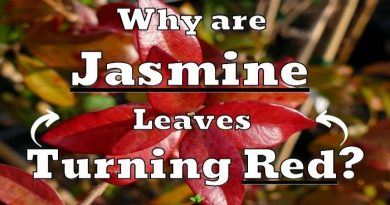Holes in Laurel Leaves: Here’s How to Treat Them!
If there are holes in the leaves or nibbled leaves on the laurel, several pests and diseases can be responsible. It is possible to combat them gently by a number of means. Here’s how to recognize them and how to nurture your laurel back to health.
| What’s causing holes in laurel leaves: |
|---|
| 1. Vine Weevil |
| 2. Shot Hole disease |
1. Vine Weevil
Although several larvae, beetles, and other insects can be considered pests on laurel trees, the vine weevil is most often responsible for the holes in the leaves. The adult vine weevil beetles feed on the green leaves. The larvae, on the other hand, are initially in the ground and then migrate upwards. They feed initially on the roots and later on the bark.
The appearance of initial holes on the laurel leaves and their edges, which eventually turn yellow, is an indication of an adult vine weevil feeding on them. These weevils cause semi-circular notches of varying sizes on the leaf edge.
An vine weevil infestation can be recognized by the following signs:
- eaten leaves
- affected leaves turn yellow.
However, the insects themselves are difficult to recognize and find, even with regular checks. Because the adult beetles are only up to one centimeter long and have a dark gray to black color.
Crucially, however, they are nocturnal and hide during the day. Checks for pests should therefore be carried out either very late in the evening or very early in the morning.
It is very important to inspect the soil for larval infestations. If vine weevils are present on laurel leaves, then most likely it doesn’t take long for the eggs to be laid in the ground, from which the voracious larvae then hatch.
It is almost too late if the laurel tree displays dry branches in addition to yellow leaves, since the roots have already been invaded by larvae.
As the vine weevil beetles cannot fly, they tend to remain in the vicinity of the infected plant and deposit their eggs there. It is recommended to combat them between April and May or August to September, which is the time when the vine weevil larvae hatch.
Treatment
Due to the possible damage to the laurel root ball, treatment must be carried out as quickly and thoroughly as possible:
- Collect bugs: The adult vine weevil insects must be collected. Otherwise, they not only cause greater feeding damage, but can also lay more eggs. Again, the early morning hours or late evening are recommended. The measure should be repeated for several days in order to eliminate as many insects as possible.
- Remove leaves: You should cut off the damaged laurel leaves in order to achieve several advantages at the same time. On the one hand, the plant benefits visually. On the other hand, entry points for pathogens are removed.
- Remove soil: Since the eggs and larvae are in the soil, the substrate must also be removed. The digging should be as far and as deep as possible. However, caution is advised so as not to damage the roots further.
- Root trimming: If the root ball is damaged, the damaged areas should be trimmed clean. This reduces the risk of rot and the roots become more receptive again.
- Bringing out nematodes: Nematodes are useful not only to avoid nibbled leaves, but also to prevent them in the future. The nematodes penetrate the larvae and destroy them from the inside. If there are no more larvae of the vine weevil, the nematodes also die. They can be purchased in specialist shops or online and are to be placed directly in the soil with the irrigation water.
- Administer nutrients: Since the pests weaken the plant and not only produce eaten leaves, fresh, nutrient-rich soil and fertilization make sense.
Tip: It is often recommended to dispose of the soil with organic waste. But it is better to kill the pests eggs with heat or to put the substrate in the residual waste. Otherwise, they will immediately spread again.
How to Prevent Pests from Eating your Laurel Leaves
If you want to reduce the risk of an infestation with pests that cause holes in your laurel leaves, preventive measures are advisable. For this purpose, the garden should be designed as natural and animal-friendly as possible.
Because this allows the natural predators of beetles and other pests to be attracted. These are birds, hedgehogs and other insects.
Suitable measures include:
- Leave piles of leaves behind;
- Build a natural stone wall with gaps;
- Hang up nest boxes;
- Plant diversity and mixed cultures;
- Offer birdseed;
2. Shot Hole disease

The rather small holes in the leaves of the laurel tree are caused by the shot hole disease fungus. The multiple holes in the leaf make it look as if someone had shot it with a shotgun, hence the name ‘shot hole disease’.
In rainy weather, especially if it lasts a long time, the fungal spores that have gotten onto the leaves by rain spray or wind will germinate soon in spring if the temperature is right.
The path is different here than in the case of an infestation with pests. The leaves initially show yellow to brown spot-like discolouration. These can overlap. Over time, the dried parts of the leaves often fall off or break off, leaving holes in the leaves. These can look like grazing marks.
There are many factors that can significantly increase the likelihood of shotgun disease in laurel trees. Pruning is by far the most important factor, but weather, too wet soil and similar conditions also play a role.
Different varieties of laurel trees have different susceptibilities, especially ‘Zabeliana’, ‘ Macrophylla ‘, ‘Otto Luyken’ and many seedlings.
Table with some varieties of laurel that are known to be resistant to shot hole disease
| Variety | Scientific Name | Resistance to Shot Hole Disease |
|---|---|---|
| Otto Luyken | Prunus laurocerasus ‘Otto Luyken’ | Highly resistant |
| Zabeliana | Prunus laurocerasus ‘Zabeliana’ | Highly resistant |
| Schipkaensis | Prunus laurocerasus ‘Schipkaensis’ | Highly resistant |
| Caucasica | Prunus laurocerasus ‘Caucasica’ | Highly resistant |
| Mount Vernon | Prunus laurocerasus ‘Mount Vernon’ | Moderately resistant |
| Newport | Prunus laurocerasus ‘Newport’ | Moderately resistant |
It is important to note that while these varieties are known to be resistant to shot hole disease, no plant is completely immune to the disease.
The best way to manage these conditions and make your skip laurel hedge less susceptible to shotgun disease (i.e., holes in laurel leaves) is to take care of your laurel.
Treatment
While laurel shot hole disease is unsightly and debilitating to the plant, it is rarely fatal and cannot be avoided entirely.
However, it is a fungus that causes shotgun disease. In order to treat this specifically, several steps are required:
- Remove affected shoots: Leaves that are already affected and discolored should be removed with clean scissors. It is best to cut these off directly on the trunk.
- Remove leaves: Leaves that have already fallen off must also be collected so that the spores do not spread further. The same rules apply to disposal as to the cut leaves and shoots.
- Use a fungicide: In order to completely destroy the germs, an appropriate agent against harmful fungi should be used. Follow the manufacturer’s instructions.
How to Prevent Shot hole disease from Causing Holes in Laurel Leaves
To prevent shot hole disease from causing holes in laurel leaves, it is recommended to prune the laurel shrub to enhance air flow and prevent foliage from getting wet by using low-volume sprinklers, drip irrigation, or sprinkler deflectors.
Additionally, it is advised to prune and dispose of diseased plant tissue as soon as it appears and to apply fixed copper fungicides or certain synthetic fungicides such as chlorothalonil. Mancozeb or products containing fixed copper are effective against shot hole if spraying a pesticide is chosen.
In order to strengthen the laurel shrubs, it is advisable to fertilize them with long-term fertilizers such as horn shavings , mature manure or compost . Spraying with horsetail is also showing good results.
Does shot hole disease go away?
As I presented above, shot hole disease affects laurel trees, causing small, circular holes in the leaves. Just like with fruit trees, shot hole disease does not go away on its own, but the severity of the disease can be managed through proper agricultural practices and fungicide applications.
Infected leaves should be pruned and removed to prevent further spread of the disease, and trees should be watered at the base rather than overhead to avoid creating conditions for the disease to spread.
Preventively, you can also apply fungicides as a treatment once symptoms are present. I usually recommend doing this before any symptoms appear.
Another thing important is to identify the specific type of laurel tree that is affected by shot hole disease, as different varieties may have different treatment options and susceptibility to the disease.
Frequently Asked Questions
Holes in laurel leaves can be caused by a variety of insects and pests, including caterpillars, weevils, slugs, and snails. These pests feed on the leaves, creating holes and notches.
While a few holes may not be harmful to the plant, severe infestations of pests can damage the leaves and weaken the plant. Additionally, pests may spread to other plants in the area.
Slugs typically chew small to medium-sized holes in leaves, while snails eat the leaves of younger plants and leave slime trails on the surfaces of leaves. Cutworms climb the stems of laurel and other shrubs and feed on leaves and buds. Vine weevil have also been known to eat bay laurel leaves.




